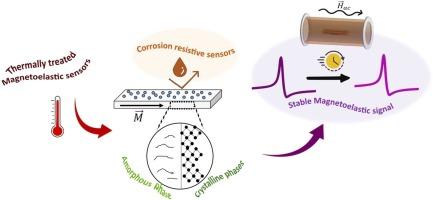几种富铁磁弹性合金自偏置响应的结晶效应
IF 6.3
2区 材料科学
Q2 CHEMISTRY, PHYSICAL
引用次数: 0
摘要
这项工作研究了热退火铁基磁弹性传感器中的自偏置效应,将之前在Vitrovac®7600上的发现扩展到设计用于增强耐腐蚀性的成分。选择FeNiCrSiB、FeCoSiB和metglass合金,评估了退火诱导结晶对其磁性、磁弹性、结构和电化学性能的影响,重点研究了它们在恶劣环境下的适用性。结果表明,在500 °C的温度下,经x射线衍射和Mössbauer能谱分析证实,合金发生了部分结晶,形成了由晶态和非晶态组成的双相结构。此外,所有处理过的样品在一个月后都表现出稳定且清晰可检测的自偏磁弹性共振,并且随着时间的推移,质量因子(FeCoSiB合金高达1050)和频率稳定性显著提高(metglass和FeCoSiB传感器的最大偏差分别降至6和12 Hz)。此外,虽然热处理对V7600和FeCoSiB的耐腐蚀性产生不利影响(腐蚀速率分别增加76%和660%),但它保持了metglass的稳定性,并大幅提高了FeNiCrSiB的性能(腐蚀速率降低55%)。这些结果突出了富铬和富镍铁基合金作为恶劣环境下自偏磁弹性传感器平台的合适候选者的潜力。本文章由计算机程序翻译,如有差异,请以英文原文为准。

Crystallization effect in the self-bias response of several Fe-rich magnetoelastic alloys
This work investigates the self-bias effect in thermally annealed Fe-based magnetoelastic sensors, extending previous findings on Vitrovac® 7600 to compositions designed for enhanced corrosion resistance. The alloys FeNiCrSiB, FeCoSiB, and Metglas were selected to evaluate the influence of annealing-induced crystallization on their magnetic, magnetoelastic, structural, and electrochemical properties, with a focus on their suitability for operation in harsh environments. The results reveal that thermal treatment at 500 °C resulted in partial crystallization, as confirmed by X-ray diffraction and Mössbauer spectroscopy, yielding a dual-phase structure composed of crystalline and amorphous regions. In addition, all treated samples exhibited stable and clearly detectable self-bias magnetoelastic resonances after one month, as well as significant improvements in quality factor (up to 1050 for the FeCoSiB alloy) and frequency stability over time (maximum deviation down to 6 and 12 Hz for the Metglas and FeCoSiB sensors, respectively). Further, while thermal annealing adversely affected the corrosion resistance of V7600 and FeCoSiB (increase in the corrosion rate of 76% and 660%, respectively), it preserved the stability of Metglas and substantially improved the performance of FeNiCrSiB (55% reduction in corrosion rate). These results highlight the potential of Cr- and Ni-enriched Fe-based alloys as suitable candidates for self-bias magnetoelastic sensor platforms to be employed in harsh environments.
求助全文
通过发布文献求助,成功后即可免费获取论文全文。
去求助
来源期刊

Journal of Alloys and Compounds
工程技术-材料科学:综合
CiteScore
11.10
自引率
14.50%
发文量
5146
审稿时长
67 days
期刊介绍:
The Journal of Alloys and Compounds is intended to serve as an international medium for the publication of work on solid materials comprising compounds as well as alloys. Its great strength lies in the diversity of discipline which it encompasses, drawing together results from materials science, solid-state chemistry and physics.
 求助内容:
求助内容: 应助结果提醒方式:
应助结果提醒方式:


